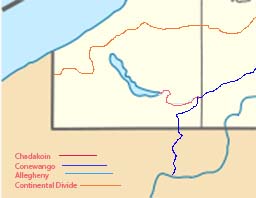Chadakoin River facts for kids
Quick facts for kids Chadakoin |
|
|---|---|

Chadakoin River (red)
|
|
| Country | United States |
| State | New York |
| Physical characteristics | |
| Main source | Chautauqua Lake New York 1,308 ft (399 m) 42°6′42″N 79°16′14″W / 42.11167°N 79.27056°W |
| River mouth | Conewango Creek Frewsburg, New York 1,238 ft (377 m) 42°5′30″N 79°8′11″W / 42.09167°N 79.13639°W |
| Length | 7.8 mi (12.6 km) |
| Basin features | |
| Basin size | 192 sq mi (500 km2) |
| Tributaries |
|
The Chadakoin River is a 7.8-mile-long (12.6 km) stream that is a tributary of the Conewango Creek. The Chadakoin lies entirely in Chautauqua County in Western New York in the United States.
The stream drains an area of 192 square miles (500 km2), covering much of Chautauqua County. The creek begins at the southern end of Chautauqua Lake. Its watershed is bounded to the north by the Chautauqua Ridge, a continental divide that results in the water flowing eventually to the Gulf of Mexico rather than the nearby Great Lakes.
Contents
History
Little is known about the indigenous population around the river prior to the 17th century; it was likely inhabited by either the Erie or the Wenro. Étienne Brûlé, the first European to explore the area, did not document what tribes lived there at the time he passed through in 1615. The Seneca people, of the Iroquois League, invaded the region in the 1650s as part of the Beaver Wars. The Chadakoin was part of their water route system that connected the Great Lakes and Canada with Pennsylvania and destinations further south.
The first recorded European exploration of the Chadakoin was by Pierre Joseph Céloron de Blainville. To strengthen France's claim to the Ohio Valley, Céloron carried out an expedition in the summer of 1749. The expedition from Montreal landed on the shore of Lake Erie, at the mouth of Chautauqua Creek in present-day Westfield, New York. The expedition carried their boats and equipment overland to Chautauqua Lake, then followed the Chadakoin River and Conewango Creek to the Allegheny River, reaching it on July 29, 1749.
The site for Jamestown was chosen in the early 1800s on the Chadakoin as a source of water power for mills. Later, flat bottomed boats brought manufactured goods from downstream to the growing village. Jamestown's mills shipped lumber downstream. Upstream traffic stopped about 1825 and by 1840 downstream commerce had ended.
As Jamestown became more populated, the area around the Chadakoin became the industrial core of the city. The river, especially below Warner Dam, was hidden by factories and sections of the river were covered by buildings. Neglected, the river became polluted and its banks were littered with trash.
The first few miles of the river, from Chautauqua Lake to Jamestown at the Fairmount Avenue bridge, are locally referred to as "The Outlet" and have been continuously used for water recreation, such as boating, canoeing and kayaking. The marsh areas along this length of the Chadakoin hold many birds and other animals. The revitalization of the riverfront that runs through Jamestown has received more attention recently, with the goal of increasing public access to the Chadakoin River by creating small parks and a pedestrian trail along the river. Recent cleanup efforts and the demolition of abandoned factory buildings have opened up the Chadakoin below Warner Dam to limited kayaking.
Historically, the river has been dyed green for Saint Patrick's Day celebrations in the city, a tradition that ended after the 2012 event due to budget cuts. The dyeing of the river resumed in 2018.
The Greater Jamestown Riverwalk is a series of parks and hiking trails along the Chadakoin River in the City of Jamestown.
Course
Flowing entirely within Chautauqua County, New York, the Chadakoin River begins by emptying Chautauqua Lake at Celoron. It then flows generally eastward through the City of Jamestown to Falconer where it is joined by a major tributary, Cassadaga Creek, four miles (6.4 km) east of Jamestown in Levant, in the town of Ellicott, New York. The river then flows south to Frewsburg where it empties into the Conewango Creek, which then flows southward into Pennsylvania and joins the Allegheny River at the city of Warren, Pennsylvania.
River modifications
Warner Dam, at Washington Street in Jamestown, controls the level of Chautauqua Lake and the flow of the Chadakoin. There is a five-foot-high (1.5 m) weir at Buffalo Street in Jamestown. There are several other river modifications. There is the former raceway that was abandoned that flowed through downtown Jamestown being diverted west of Main street flowing under Main street and buildings to power the Broadhead Mills. Also, there are many retaining walls along the river including 2nd street, railroad tracks from main to institute st, building on institute street, parking lot for St.James church, The former Artone building, Former Crescent Tool building, A break wall or former wier near Winsor St., Rear of building on Willard st., Webber Knapp building, walls at former Dahlstrom building, Break wall or partial wier at Hopkins Ave. There are other obstructions in the village of Falconer.
Natural History
The Chadakoin is inhabited by Beaver which are downing trees along its shore throughout the entire ciy of Jamestown. The Chadakoin is also a habitat for the Spiny softshell turtle.

